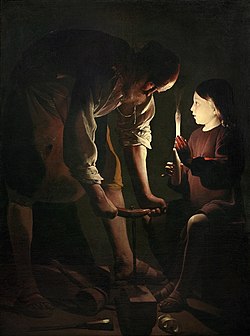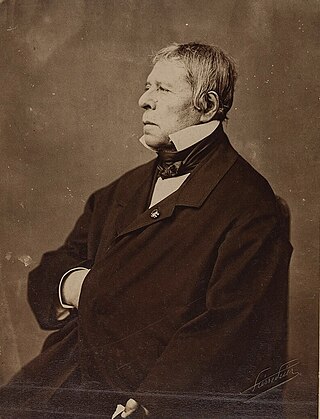
Jean-Auguste-Dominique Ingres was a French Neoclassical painter. Ingres was profoundly influenced by past artistic traditions and aspired to become the guardian of academic orthodoxy against the ascendant Romantic style. Although he considered himself a painter of history in the tradition of Nicolas Poussin and Jacques-Louis David, it is his portraits, both painted and drawn, that are recognized as his greatest legacy. His expressive distortions of form and space made him an important precursor of modern art, influencing Picasso, Matisse and other modernists.
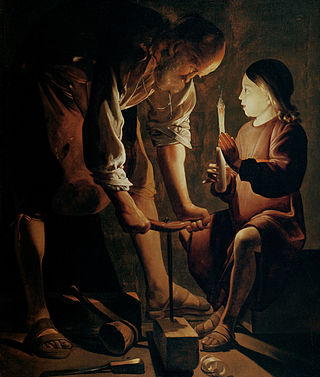
Georges de La Tour was a French Baroque painter, who spent most of his working life in the Duchy of Lorraine, which was temporarily absorbed into France between 1641 and 1648. He painted mostly religious chiaroscuro scenes lit by candlelight.

Jean Restout the Younger was a French artist, who worked in painting and drawing. Although little remembered today, Restout was well-respected by his contemporaries for his religious compositions.

Caravaggio created one of his most admired altarpieces, The Entombment of Christ, in 1603–1604 for the second chapel on the right in Santa Maria in Vallicella, a church built for the Oratory of Saint Philip Neri. A copy of the painting is now in the chapel, and the original is in the Vatican Pinacoteca. The painting has been copied by artists as diverse as Rubens, Fragonard, Géricault and Cézanne.

Saint Irene of Rome was a Christian woman in the Roman Empire during the reign of Diocletian. She was the wife of Saint Castulus. According to Christian legend, she attended to Saint Sebastian after he was wounded by Mauretanian archers.

Melchior Broederlam was one of the earliest Early Netherlandish painters to whom surviving works can be confidently attributed. He worked mostly for Philip the Bold, Duke of Burgundy, and is documented from 1381 to 1409. Although only a single large pair of panel paintings can confidently be attributed to him, no history of Western painting can neglect his contribution.
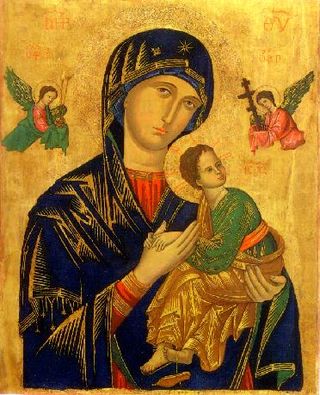
Mary has been one of the major subjects of Western art for centuries. There is an enormous quantity of Marian art in the Catholic Church, covering both devotional subjects such as the Virgin and Child and a range of narrative subjects from the Life of the Virgin, often arranged in cycles. Most medieval painters, and from the Reformation to about 1800 most from Catholic countries, have produced works, including old masters such as Michelangelo and Botticelli.
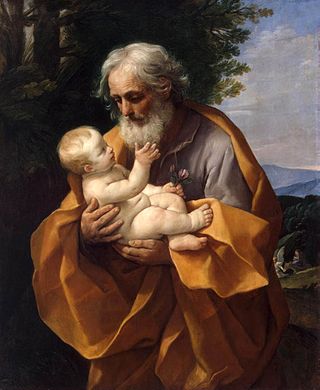
Joseph was a 1st-century Jewish man of Nazareth who, according to the canonical Gospels, was married to Mary, the mother of Jesus, and was the legal father of Jesus.

Magdalene with the Smoking Flame is a c. 1640 oil-on-canvas depiction of Mary Magdalene by French Baroque painter Georges de La Tour. Two versions of this painting exist, one in the Los Angeles County Museum of Art and the other in the Louvre Museum.

Saint Sebastian Tended by Irene is an oil-on-canvas painting by Hendrick ter Brugghen dated to 1625. Now in the Allen Memorial Art Museum of Oberlin, Ohio, the piece depicts the Roman Catholic subject of Saint Sebastian Tended by Saint Irene, after Irene of Rome and her maid rescued him following his attempted martyrdom by the Roman authorities. An exemplary piece of the Italianate Baroque tendency in Dutch Golden Age painting, the painting employs dramatic uses of light and skillful chiaroscuro to depict its religious subject, evidence of influence from Caravaggio and Ter Brugghen's fellow Utrecht Caravaggisti.

Portrait of Madame Aymon, La Belle Zélie is an 1806 oil on canvas painting by the French artist Jean-Auguste-Dominique Ingres. The painting is one of Ingres' early painted portraits, completed just before his first stay in Rome. It first came to public notice during an 1867 Ingres exhibition in Paris, and was acquired by the Musée des Beaux-Arts de Rouen in 1870.

Saint Sebastian Tended by Saint Irene is a c.1649 oil-on-canvas painting by Georges de La Tour. It is one of the largest known paintings by the artist and his most ambitious composition. It was rediscovered in 1945 in the parish church of Bois-Anzeray and acquired by the Société des amis du Louvre for the Louvre in 1979 as inventory number R.F. 1979–53.
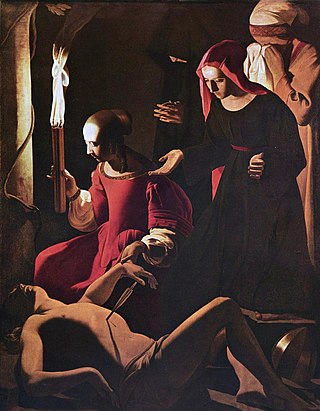
Saint Sebastian Tended by Saint Irene is a c. 1634–1643 oil-on-canvas painting of Saint Sebastian having his wounds tended by Saint Irene, which suddenly became a popular subject in the 1620s. It is now in the Gemäldegalerie, Berlin.
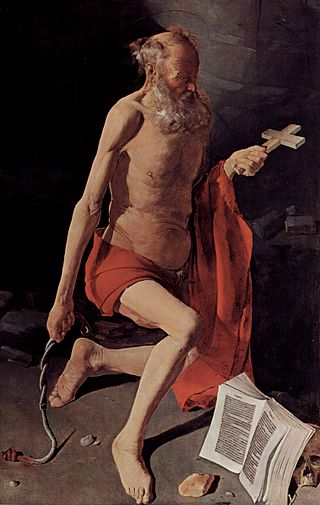
St Jerome at Prayer is an oil-on-canvas painting executed ca. 1630–1635 by the French artist Georges de La Tour. He produced it for the abbey of Saint Antoine a Viennois, but it was confiscated by the state on the French Revolution and is now in the Museum of Grenoble. An autograph copy with some variations was produced sometime before 1642 and is now in the Nationalmuseum in Stockholm.

The Newborn Child is an oil-on-canvas painting created c. 1645–1648 by the French painter Georges de La Tour, now in the Museum of Fine Arts of Rennes in France. It is sometimes thought to be a representation of the Madonna and Child in the form of a genre scene – it is thus also known as The Nativity.

The Adoration of the Shepherds is a 1644 oil-on-canvas painting by the French artist Georges de La Tour. It is now in the Louvre Museum, in Paris, which purchased it in 1926.

Magdalene with Two Flames or The Penitent Magdalene is an undated oil-on-canvas painting created c.1640 by the French painter Georges de La Tour. In 1978 Mr. and Mrs. Charles Wrightsman gave it to the Metropolitan Museum of Art in New York, where it still hangs.
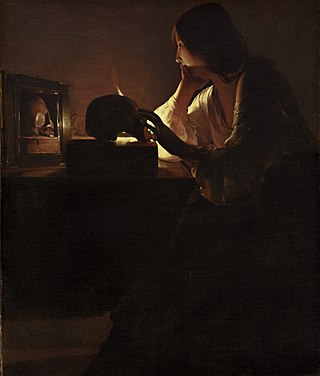
Magdalene at a Mirror or The Repentant Magdalene is a c.1635-1640 oil-on-canvas painting by the French artist Georges de La Tour. It passed from the Marquise de Caulaincourt to the Comtesse d'Andigné in 1911, before being bought in 1936 by André Fabius – it is sometimes known as The Fabius Magdalene as a result. It was then unattributed but Louvre experts attributed it to de la Tour in 1937. Fabius could not find a buyer in France and so in 1964 sold it to the National Gallery of Art in Washington, where it still hangs, though this caused a legal case since Fabius had not sought an export licence to remove the work from France.
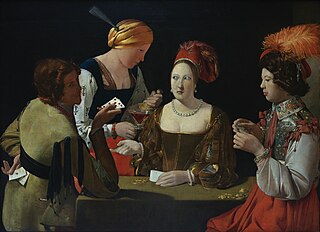
The Card Sharp with the Ace of Diamonds is an oil-on-canvas painting produced c. 1636–1638 by the French artist Georges de La Tour. It is now in the Louvre, which bought it in 1972. Though its commissioner is unknown, it is signed Georgius De La Tour fecit under the card sharp's elbow and in the shadow of the tablecloth.
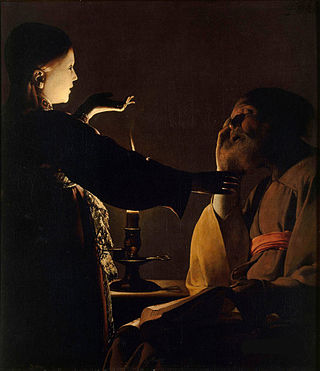
The Dream of Saint Joseph is an oil-on-canvas painting created between 1628 and 1645 by the French Baroque painter Georges de La Tour which is now in the collection of the Musée d'Arts de Nantes.
